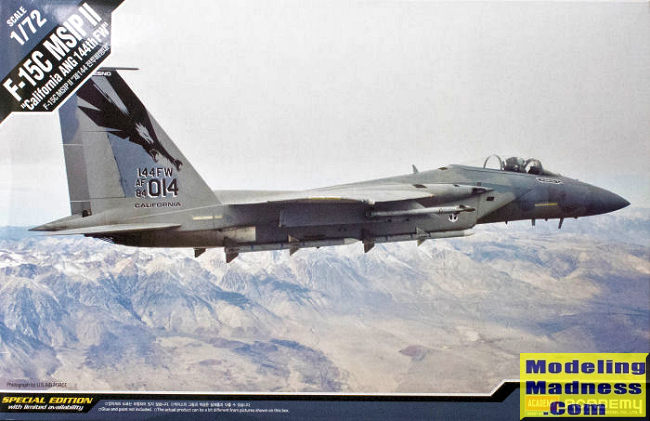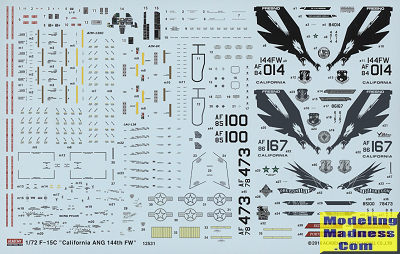
Academy 1/72 F-15C Eagle (MSIPII)
| KIT #: | 12531 |
| PRICE: | $24.00 shipping included |
| DECALS: | Four options |
| REVIEWER: | Scott Van Aken |
| NOTES: | 2016 release |

| HISTORY |
The Multi-Stage Improvement Program (MSIP) is a joint program carried out by McDonnell Douglas and the USAF's Warner Robins Logistics Center in Georgia. Under MSIP, upgrades were progressively incorporated onto the production line and then retrofitted to earlier production aircraft.
MSIP II is that portion of the program which handles the F-15C/D. The major part of MSIP II is to fit the APG-70 radar and the AIM-120 AMRAAM.
The Electronic Warfare Warning Set (EWWS) was modified into the more capable Tactical Electronic Warfare System (TEWS) with an ALQ-135 electronic countermeasures set and an upgraded ALR-56C radar warning receiver. An overload warning system was provided to prevent pilots from accidentally exceeding 9g during combat maneuvering.
The F-15C/D aircraft going through the MSIP II were fitted with the wiring needed to give them the capability of carrying and launching the AIM-120 AMRAAM missile, which was introduced into service in the early 1990s.
Another part of the MSIP II was the Seek Talk program, which was designed to reduce the vulnerability of the F-15's UHF radios to enemy jamming by introducing spread spectrum techniques and the use of a null steering antenna. Yet another was the Joint Tactical Information Distribution System (JTIDS), which is intended to provide high-capacity, reliable, and jam-proof information distribution between various elements of deployed forces and command and control centers. Another aspect of the MSIP is the integration of the F-15 with the Global Positioning Satellite (GPS). A new multi-function display armament control panel was introduced. New stick-top and throttle grips were added. The ECM equipment was improved, with ALR-56C RWR, ALQ-135B internal ECM system, and enhanced ALQ-128 being introduced.
The major part of MSIP II involved the development an upgraded AN/APG-63 radar, which is so much improved that is given the new designation of AN/APG-70. In this unit, the radar data processor memory was increased from 16K to 24K, and its processing speed was increased by a factor of three. The memory capability of the APG-63 radar fire control system was increased from 96K to 1000K and the processing speed was trebled. A Programmable Armament Control Set (PACS) was installed. The new unit has multiple bandwidths for high-resolution ground mapping using SAR technology. Several new radar modes were added, such as track-while-scan, which made it possible to ripple-fire up to four BVR missiles at separate targets simultaneously. The APG-70 radar also had a Low Probability of Intercept (LPI) capability, which makes it possible for it to detect and direct attacks on enemy aircraft without its emissions being easily seen by the enemy. The new processing power made available with the use of the new APG-70 radar made it practical to make use of Non-Cooperative Target Recognition (NCTR) technology, which provides the ability to distinguish more reliably between friendly and hostile aircraft. Much of the NCTR technology is highly "black" and very few details are available, but it reportedly makes it possible to avoid a lot of "friendly fire" accidents, such as the one that resulted in the loss of the IranAir Airbus in July of 1988.
| THE KIT |
 This
kit was purchased in anticipation of using it for some of the more recent
F-15C/D decal sheets that require an MSIP II level F-15. To be quite honest,
there isn't all that much that is visually different between a standard C/D and
the MSIP II aircraft that couldn't be duplicated with scrap card. That is
because, externally, all one does is replace the lower antennas with different
ones. Internally, the instrument panel is different, and apparently this kit
does provide that, an easy job as the instrument panel is a decal. In fact, you
could quite easily use this kit to build an F-15A so you may want to keep that
in mind if you can find this one at a good price as did I.
This
kit was purchased in anticipation of using it for some of the more recent
F-15C/D decal sheets that require an MSIP II level F-15. To be quite honest,
there isn't all that much that is visually different between a standard C/D and
the MSIP II aircraft that couldn't be duplicated with scrap card. That is
because, externally, all one does is replace the lower antennas with different
ones. Internally, the instrument panel is different, and apparently this kit
does provide that, an easy job as the instrument panel is a decal. In fact, you
could quite easily use this kit to build an F-15A so you may want to keep that
in mind if you can find this one at a good price as did I.
In line with most 1/72 F-15 kits, this one splits the fuselage into top and bottom with the cockpit areas as part of the lower fuselage. The upper cockpit piece is separate to accommodate the insert for the B/D model, though that is not included with this kit. As mentioned, instruments are decals, which is fine for this scale. There is a single instrument panel and control stick that are inserted into the tub afore that it attached to the lower fuselage. This kit does provide full intake trunking and while it will be a pain to get rid of the seam, it is great that it is provided.
The upper fuselage contains the upper wing section and one simply attaches the lower wing. The lower wing has the pylon holes already opened up so those wanting a clean plane will need to fill those. You are provided two different type of burner cans. One is the old Turkey Feathers variety that are a single piece and not appropriate anything but the first years of operation. The later variety with the exposed linkage is also provided and these are a bit of a complex build, but should be esay enough.
Fins and stabilizers are a single piece with the left fin
having a separate tip as not all Eagles used the US antenna. Intakes are three
pieces for each side and you have option of straight or lowered intake fronts.
There is then a ramp that fits inside prior to your attaching these to the
fuselage. While the kit is designed for gear down, and the gear is nicely done,
you can build this gear up if you are so inclined. The new sprue consists of the
update missile suite of late model Sidew inders
and the AIM-120 missiles with their respective pylons. An additional fuel tank
is also included for the centerline. The holes for the centerline pylon are also
opened up for you. Other options are open or closed canopy, extended entry
ladder, and a raised or lowered speed brake.
inders
and the AIM-120 missiles with their respective pylons. An additional fuel tank
is also included for the centerline. The holes for the centerline pylon are also
opened up for you. Other options are open or closed canopy, extended entry
ladder, and a raised or lowered speed brake.
Instructions are well done with a number of different paint company references. Four ANG options are included, all painted Mod Eagle. Two are from the 194 FS at Fresno, California, while the other two are with the 123 FS at Portland, Oregon. The decals sheet is very nicely done and typical of the F-15, a ton of stencils are provided.
| CONCLUSIONS |
It would be difficult to tell you how well the kit will build without having done so, but I have had good experiences with other Academy kits and am sure this one will make into a very nice model.
| REFERENCES |
http://www.joebaugher.com/usaf_fighters/f15_25.html
April 2018 Copyright Modeling Madness.com. All rights
reserved. Thanks to me for getting this one on sale. If you would like your product reviewed fairly and fairly quickly, please
contact
the editor or see other details in the
Note to
Contributors. Back to the Main Page
Back to the Review
Index Page
Back to the Previews Index Page